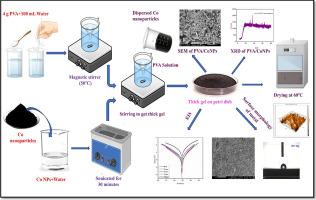Chemical and electrochemical investigation of poly (vinyl alcohol) cobalt nanoparticles composite as corrosion inhibitor for soft-cast steel in 1 M HCl medium
IF 6.3
2区 材料科学
Q2 CHEMISTRY, PHYSICAL
引用次数: 0
Abstract
A novel polyvinyl alcohol/cobalt nanoparticle (Co-PVA) nanocomposite was synthesized and thoroughly characterized using a range of analytical techniques, including Fourier-transform infrared spectroscopy (FTIR), X-ray diffraction (XRD), and scanning electron microscopy (SEM). The SEM analysis revealed that the cobalt nanoparticles within the composite possess a spherical morphology. Additionally, both XRD and SEM results confirmed the successful incorporation of elemental cobalt into the polymer matrix. The effectiveness of the Co-PVA nanocomposite as a corrosion inhibitor for soft cast steel (SCS) in a 1 M HCl solution was evaluated through a series of experiments, including weight loss measurements, electrochemical testing. The findings indicate that the Co-PVA nanocomposite serves as an efficient corrosion inhibitor for SCS. Notably, the composite achieved a maximum inhibition efficiency of 96.9 at 303 K, as determined by weight loss measurements. Electrochemical analysis through potentiodynamic polarization revealed that the Co-PVA nanocomposite acts as a mixed-type inhibitor, influencing both anodic and cathodic reactions. The adsorption behavior of the composite onto the SCS surface was found to follow the Langmuir adsorption isotherm, suggesting a uniform and strong interaction between the inhibitor and the metal surface. The formation of a protective film by the Co-PVA nanocomposite on the SCS surface was corroborated by AFM, SEM, EDS, XPS, and water contact angle measurements, highlighting the composite's potential as a robust corrosion inhibitor in acidic environments.

聚乙烯醇钴纳米复合材料在1m HCl介质中作为软铸钢缓蚀剂的化学和电化学研究
合成了一种新型聚乙烯醇/钴纳米颗粒(Co-PVA)纳米复合材料,并利用傅里叶变换红外光谱(FTIR)、x射线衍射(XRD)和扫描电子显微镜(SEM)等分析技术对其进行了全面表征。SEM分析表明,复合材料内的钴纳米颗粒具有球形形貌。此外,XRD和SEM结果都证实了元素钴成功掺入到聚合物基体中。通过一系列实验,包括失重测量、电化学测试,评估了Co-PVA纳米复合材料作为软铸钢(SCS)在1 M HCl溶液中的缓蚀剂的有效性。研究结果表明,Co-PVA纳米复合材料是一种高效的SCS缓蚀剂。值得注意的是,通过失重测量,该复合材料在303 K时达到了96.9的最大缓蚀效率。通过动电位极化分析表明,Co-PVA纳米复合材料作为一种混合型缓蚀剂,对阳极和阴极反应均有影响。复合材料在SCS表面的吸附行为遵循Langmuir吸附等温线,表明抑制剂与金属表面具有均匀且强的相互作用。通过AFM、SEM、EDS、XPS和水接触角测量证实,Co-PVA纳米复合材料在SCS表面形成了保护膜,这表明该复合材料在酸性环境中具有强大的缓蚀剂潜力。
本文章由计算机程序翻译,如有差异,请以英文原文为准。
求助全文
约1分钟内获得全文
求助全文
来源期刊

Surfaces and Interfaces
Chemistry-General Chemistry
CiteScore
8.50
自引率
6.50%
发文量
753
审稿时长
35 days
期刊介绍:
The aim of the journal is to provide a respectful outlet for ''sound science'' papers in all research areas on surfaces and interfaces. We define sound science papers as papers that describe new and well-executed research, but that do not necessarily provide brand new insights or are merely a description of research results.
Surfaces and Interfaces publishes research papers in all fields of surface science which may not always find the right home on first submission to our Elsevier sister journals (Applied Surface, Surface and Coatings Technology, Thin Solid Films)
 求助内容:
求助内容: 应助结果提醒方式:
应助结果提醒方式:


